
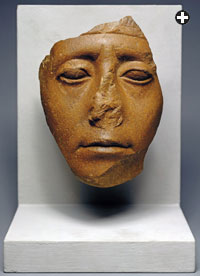 |
|
metropolitan museum of art / art resource |
|
If a story recounted by Aristotle is to be believed, then it was Pharaoh Senwosret iii who,
in the mid-19th century bce, first ordered construction of a canal from the Nile to the Red
Sea. He did not succeed. Below: Some 3800 years later, French cartographers noted on this map of the Nile Delta the route of
the first canal, from Bilbeis to Suez, but they left out the more recent Roman and Arab canal, which extended to Cairo.
|

is the year 638 ce, the "Year of Ashes" on the Arabian Peninsula, which is beset by a terrible
drought. Just six years after the death of the Prophet Muhammad, the holy cities of Makkah and Madinah find themselves in dire
peril, their citizens, and many refugees from the countryside, facing starvation. Casting around for assistance, Caliph 'Umar
ibn al-Khattab writes from Madinah to 'Amr ibn al-'As, his general in Egypt, urging him to send food to feed th1e hungry in the
Hijaz, the Islamic heartland.
'Amr had not yet completely subdued Egypt when he received the caliph's orders, but the historical record tells us that he did
not stint, sending a huge camel caravan laden with food, most likely wheat and barley, to 'Umar. The caravan made its way from
the Nile Valley across the Sinai Peninsula, then south through the Hijaz Mountains to Madinah, a journey of some 1300 kilometers
(800 mi) that took a month to complete.
The caravan leader carried a response from 'Amr to the caliph. "I have sent you camels," he wrote. "The first is with you in
Madinah; the last is just leaving me in Egypt." In between, says the ninth-century Egyptian historian Ibn 'Abd al-Hakam, an
unbroken file of animals carried the bounty of the Nile to the Hijaz. When they reached Madinah, 'Umar allocated one camel,
with its load, to each household. Both the animals and their cargo were eaten by the hungry recipients. Other caravans came
from lands to the north, and catastrophe was thus narrowly averted.
The effort had stretched caravan transport to its limits, however, and the lesson of the vulnerability of the Holy Cities,
as well as the importance of the bounty of Egypt, was not lost on the caliph. 'Umar wrote again to 'Amr with a plan. "I wish
to excavate a canal from Egypt's Nile, so that its waters will flow to the sea," Ibn 'Abd al-Hakam quotes 'Umar as saying.
"That way, it will be easier to transport food to Makkah and Madinah. Consult among yourselves to settle the matter."
'Umar's idea was not as extraordinary as it first sounds. In fact, it was based on the memory that such a canal had in fact
existed when Egypt was under Roman rule, and that ships carrying grain from Egypt had indeed sailed to the Hijaz in the past.
By the time of the Islamic conquest of Egypt, however, the canal had fallen out of use and was blocked with sand and debris.

zev radovan / bridgeman art library
|
It was the Persian king Darius i ("the Great"), depicted above on a gold coin issued during his
reign in the fifth century bce, who opened the first canal for which we have archeological evidence.
Lower: Inscriptions on this stele, found in 1866 near Suez and now in the Louvre in Paris, testify
to Darius's achievement.
|
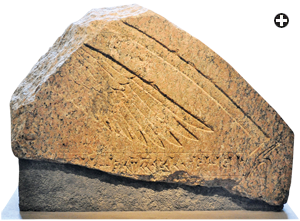
jona lendering / www.livius.org
|
'Amr's companions were perturbed by 'Umar's plan, and the leaders of Egypt's native Copts were particularly displeased, for
they doubted the project would be as commercially beneficial for them as it would be for Arabia. Ibn 'Abd al-Hakam reports that
they urged 'Amr to impress upon 'Umar that the project "is immoderate. It will not happen. We don't see a way." But 'Umar was
not to be deterred. "I shall make it a command that no ship shall sail in the [Red] sea except with food for the peoples of
Makkah and Madinah," he vowed.
When 'Amr realized 'Umar was in earnest, he quickly set about the task of restoring the ancient Nile-Red Sea canal. According
to Ibn 'Abd al-Hakam, a Copt showed 'Amr the route of the old Roman canal. In return, he and his family were exempted from the
poll tax. For the most part, the Canal of the Commander of the Faithful, as it was named in honor of the caliph, followed the
route cut by the Roman canal, with one major exception: It had to find a new connection to the Nile to avoid land already
earmarked for the construction of Fustat, Egypt's new Islamic capital, the predecessor of modern Cairo. The new canal mouth
was located at the site of today's Sayyida Zaynab Square in the heart of Cairo.
From its mouth on the Nile to its terminus at the Red Sea port of al-Qulzum (modern Suez), the canal coursed a remarkable
170 kilometers (105 mi). The 14th-century Mamluk historian Ibn Duqmaq tells us: "No sooner had ['Amr] brought effort to bear
than ships were moving in it as they had before. Ships were arriving in the Hijaz in the seventh month [after the start
of excavation]." 'Amr himself traveled on one of those ships to make the pilgrimage to Makkah.
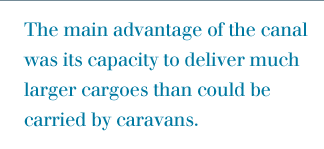 |
The canal took advantage of some features of the Egyptian landscape. The first section followed the eastern fringe of the
low-lying Nile Delta for about 80 kilometers (50 mi), and then struck east for around 65 kilometers (40 miles) along the
Wadi Tumaylat. That was a dry east-west valley that had been cut through the northern extension of the Muqattam Hills by an
ancient branch of the Nile that had once emptied into the Red Sea instead of the Mediterranean. The final leg south to the
sea at al-Qulzum followed the Isthmus of Suez, a tectonic depression along which the modern Suez Canal runs today.
The main advantage of the canal was not so much enhanced speed as its capacity to deliver large amounts of strategic food
reserves to the granaries of Arabia. The Fatimid-era author Ibn Tuwayr reports that it took five days for a flat-bottomed
Nile vessel to travel the length of the canal—two or three days longer than by camel. And at al-Qulzum, the cargo had
to be transferred onto seagoing vessels, further slowing its journey. Moreover, the canal could only be used part of the year,
during the annual Nile flood from September to around February. Nevertheless, a single Nile barge or Red Sea ship could replace
a large number of camels and operate at a much lower cost. And the steady northerly winds that blow from al-Qulzum in the
northern Red Sea would have enabled ships to arrive at the ports of the Hi
jaz in less than two weeks, safe from the predations of desert raiders.
'Umar's canal transformed the fortunes of the Holy Cities, bringing unprecedented food security to the residents of the Hijaz.
Egypt had once been the breadbasket of Rome and Byzantium; now its rich soils could sustain the Islamic heartlands.
 |
|
scala / art resource |
|
Greek historian Herodotus wrote the first eyewitness account of a Nile-to-Red-Sea canal:
"Four days' voyage in length," its width likely exceeded 25 meters, for he noted it was
"dug wide enough for two triremes to move in it rowed abreast."
|
The scheme to supply the Hijaz with Egyptian food was not without its teething problems, however, and the villains of the
piece, financial speculators, are familiar to the modern reader. To ensure fair distribution of Egyptian grain when shipments
arrived at al-Jar, the port of Madinah, 'Umar issued ration certificates to the people that entitled them to a share of the
supplies. Initially, the situation was desperate and people were hungry. But soon a secondary market in the certificates emerged,
and prices soared. Certain traders, including one dealer named Hakim bin Hizam, were accused of profiteering. 'Umar ruled that
trade in certificates for food that had not yet arrived was unethical, and Hakim was ordered to make amends by distributing his
profits to the poor.
'Umar was the latest in a long line of leaders to have pursued the idea of joining the Red Sea at Suez to the Nile, either to
link the Nile Valley to the eastern seas or to serve as a bridge between the Red Sea and the Mediterranean. While the notion of
a Suez canal is today usually associated with the great 19th-century engineer Ferdinand de Lesseps, the Frenchman was actually
heir to an ambition that goes back 2500 years, and possibly more.
When the Greek historian Herodotus visited Egypt in the mid-fifth century bce, he saw for himself
the first of the Nile-Red Sea canals for which we have clear archeological evidence: that of the Persian king Darius the Great
(522–486 bce). "This [canal] is four days' voyage in length," wrote Herodotus, "and it was
dug wide enough for two triremes to move in it rowed abreast"—a width of at least 25 meters (82'), allowing a little for
clearance.
Darius himself showed no false modesty about his achievement. He dotted the route of his canal, which started near Bubastis on
the easternmost branch of the Nile, with four prominent monuments inscribed in hieroglyphs, Old Persian, Elamite and Babylonian.
On them he boasted: "I am a Persian; from Persia I seized Egypt; I gave orders to dig this canal from [the] Nile to the sea
which goes from Persia. Afterward, this canal was dug as I had ordered, and ships went from Egypt through this canal to Persia."
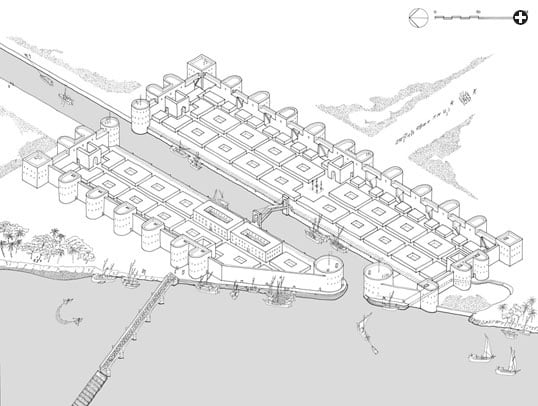 |
|
nicolas warner / american research center in egypt |
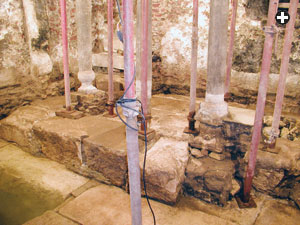 |
|
peter sheehan |
|
The Roman canal opened to the Nile at a port known as Babylon. Near this site,
depicted top, some 500 years later, the first Islamic capital in Egypt was founded,
and 300 years after that, the city of Cairo. Since Roman days, the Nile has moved west
by nearly a kilometer, and Cairo's Metro rail line runs nearly along the old embankment.
Above: Once part of a quay, these recently excavated steps are among the few remaining traces of the canal.
|
Apart from demonstrating Persian imperial power to his Egyptian subjects, Darius's canal was also about booty: exporting the
wondrous, and often heavy, products of the Nile to Persia. Indeed, the famous statue of Darius himself that was discovered by
archeologists in 1972 at Susa—carved in an Egyptian style out of greywacke sandstone quarried in Egypt's Eastern
Desert—must have been shipped to Persia via the canal.
There may have been even earlier attempts to cut a canal to the Red Sea. The Greek philosopher Aristotle recounts a story that
a pharaoh called Sesostris—probably Senwosret iii (1845–1837
bce)—contemplated digging one, but gave up for fear that the sea would flood Egypt. And
Herodotus himself says that a pharaoh named Neccho, probably the 26th-Dynasty ruler Neccho ii,
started work on a canal some 12 centuries later, but halted when a soothsayer advised him to turn his attentions to war in the
Levant instead. According to Herodotus, 120,000 people died in the excavation attempt.
We do not know for certain that the Persian canal ever truly fell out of use, but Ptolemy ii
Philadelphus, who reigned from 283 to 246 bce, claims credit for having excavated a new one.
In fact, several ancient Greek authors, their anti-Persian prejudices showing, falsely claim that Ptolemy ii
was the first to succeed in cutting a canal to the sea, and that Darius before him had failed.
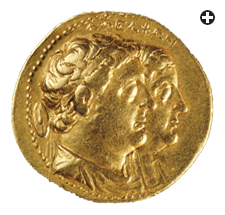
gianni dagli orti / art resource
|
|
Above: We do not know whether or not Darius's canal ever fell out of use, but in the third
century bce, Egyptian ruler Ptolemy ii Philadelphus claimed credit
for excavating a new one, and he named its Red Sea port after his queen, Arsinoe ii, who appears next to him on this
gold eight-drachma coin. Lower: In the early second century ce, Roman emperor Trajan extended
the canal south to the Nile at Babylon, both to boost trade and to project naval power into
the Red Sea.
|
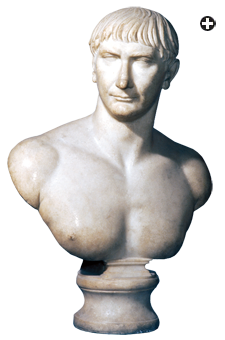
british museum / art resource
|
If Darius's canal was about transporting imperial loot out of Egypt, then the Ptolemaic canal reversed that direction. Under the
dynasty established by the successor of Alexander the Great, Egypt was no longer the vassal of a foreign power, but the seat of an
empire in its own right. Ptolemy faced competition abroad, from the Seleucids who had inherited the eastern territories of Alexander's
empire. They had access to war elephants from India, and to match them in the imperial arms race, the Ptolemies needed elephants of
their own. The solution lay in an expedition south along the African coast of the Red Sea to what today are Sudan and Eritrea.
A hieroglyphic stone uncovered by Swiss archeologist douard Naville at Tell al-Maskhuta in Wadi Tumaylat in the late 19th century
boasts of Ptolemy's excavation of the canal. It tells how the pharaoh sent one of his generals on an expedition via his newly
excavated canal to establish a colony: "He made there fields and cultivated them with plows and cattle. He caught elephants in
great number for the king, and he brought them as marvels for the king on his vessels on the sea. He brought them also on the
Eastern Canal; no such thing had ever been done by any of the kings of the whole earth."
But it was the first-century Roman emperor Trajan whose canal-digging efforts left the greatest legacy for 'Umar to exploit in
his seventh-century relief of the Holy Cities. Earlier canals had departed from the Nile along its easternmost branch. By Trajan's
time, however, that branch was beginning to dwindle, so his engineers came up with the idea of extending the new canal south,
upstream, beyond the head of the Delta, to the fort of Babylon in today's Old Cairo. Probably more than any other act, this decision
determined the location of Egypt's capital today.
The emperor Diocletian (reigned 284–305 ce) added new fortifications to the fort and the
canal mouth in the late third and early fourth centuries ce, and it was there, 350 years later,
that Egypt's Byzantine rulers made their last stand against 'Amr's army. It was outside the walls of the fort that the besieging
'Amr pitched his tent, and it was around his tent that the new Islamic capital of Fustat was founded. And three centuries later,
it was nearby, along the Trajanic canal's east bank, that the Fatimids would lay out their fabulous new city of Cairo in 969
ce.
Trajan's canal looked east to naval dominance of the Red Sea, to links with the newly conquered province of Arabia Petrea, to
the mines and quarries of Egypt's Eastern Desert, to the important incense-producing lands of Arabia Felix and to the growing
trade in luxury goods with India and East Africa. But the canal also served a more regional trade. The large number of late-Roman
Egyptian amphorae that archeologists have found at Aqaba, at modern Jordan's southern tip, suggest that Egyptian wine might have
been one of the canal's exports. From the writings of Ibn 'Abd al-Hakam, it appears that Egyptian grain was also being traded in
the Hijaz, implicitly via a canal, in the period before Islam.
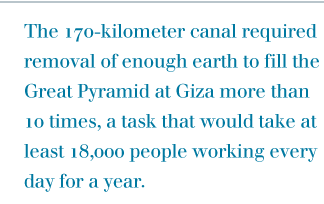 |
Building the canal, in any era, was no mean feat. Herodotus's claim that Neccho's attempt cost 120,000 lives smacks of hyperbole,
but it may be based on a kernel of truth. In the early 19th century, when the Egyptian ruler Muhammad Ali built a new 80-kilometer
(50-mi) canal from Cairo to Alexandria, using conscript labor and hand tools, reports said that 20,000 people died in the process.
The much longer Red Sea canal probably required the removal of more than 24 million cubic meters of earth (31.5 million cubic
yards), almost 10 times the volume of the Great Pyramid of Cheops at Giza. From scratch, that would probably have taken 18,000
people working every day for a year to achieve. And with silt carried by the river and sand blown in from the desert, maintaining
the canal as a working waterway would have been a never-ending process. In that respect, 'Amr's re-excavation of the Roman canal
would have been relatively easier to do, since it was largely a case of clearing out the course of the defunct Roman canal. 'Amr's
route diverged from the Roman one only in making a new connection to the river that avoided Fustat.
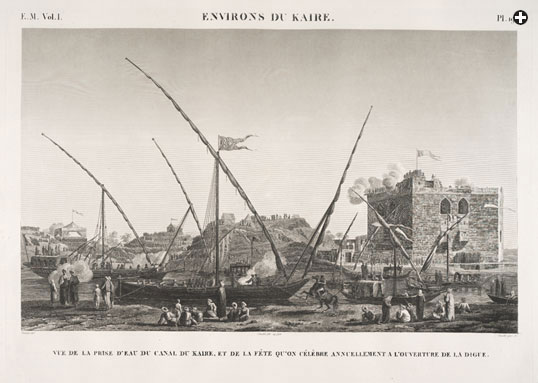 |
|
linda hall library |
 |
|
john cooper |
|
The canal was open only a few months each year. Only when the Nile flood rose high enough,
as measured on the Nilometer, above, was the signal given to open the canal. This occasioned annual
festivities, as an engraver depicted, top, in this plate published in the Description de l'Egypte. |
The fact that the Nile–Red Sea canal operated seasonally also made maintenance of the waterway easier. From about
January to August, the water level of the Nile was too low to fill the canal, rendering it idle. During this time, workers
could have labored to keep it clear.
When the Nile began to rise in June, the entrance of the canal, like those of others throughout Egypt, would have been blocked
by a temporary earth dam. Medieval historians tell us that it was only when the Nile reached 16 cubits (about 8.3 meters, or
nearly 28') on the scale of the great Nilometer on Roda Island in Cairo that the signal to break the dam was given. That event
was surrounded by great festivities, since the 16-cubit mark meant not only that the canal would flow again, but also that the
annual flood was considered "complete": Egypt would be irrigated, famine averted, and authorities would be able to levy the full
land tax at harvest time.
What became of Caliph 'Umar's canal? It operated for about 114 years, carrying agricultural produce to Arabia, until, in 754
and 755 ce, there was an uprising in Madinah against the new Abbasid caliphate in Baghdad. The
caliph, al-Mansur, ordered the canal blocked to cut the supply of food to the Holy Cities and choke off the rebellion—an
exact reversal of 'Umar's motivation for reopening it in the first place. The Canal of the Commander of the Faithful continued
to flow through Cairo and as far as the central Wadi Tumaylat—about half its original length—throughout the medieval
period, becoming known as the Cairo Canal.
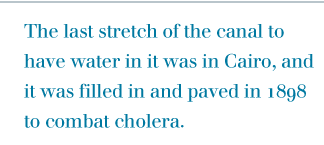 |
On seeing the vestiges of the canal in 1776, the Franco-Hungarian officer Baron de Tott reckoned that it could be restored
with only a little excavation work. Maps from the early 19th century still showed its course running all the way to Suez. Early
in the 20th century, the French archeologist Claude Bourdon found extensive remains of the ancient canal mouth and its associated
harbor in the sea lagoon at Suez, and more recent work by Peter Sheehan, who directed archeological work in Old Cairo by the American
Research Center in Egypt, has pinpointed the entrance of the Roman canal under the modern buildings and streets there.
Although it had remained visible for millennia, the last 150 years have not been so kind to what is left of the ancient Suez canal:
Its traces have been almost entirely obliterated by agricultural and urban development. At Suez, where 90 years ago Bourdon had been
able to map the concrete wharves and jetties of the ancient Roman and Islamic harbor, urban expansion, land reclamation, unregulated
dumping and excavation for fish farms have heavily encroached upon the archeological remains.
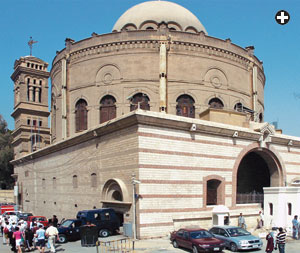 |
|
john cooper |
|
The uniquely circular St. George's Church in Cairo is built on the foundation of one of the
two Roman towers that flanked the entrance to the canal.
|
The last surviving stretch of the canal with water in it, the portion running through Cairo, was filled in and paved in 1898 to
combat cholera. If you go to Cairo today, you will be hard pressed to find any explicit evidence that the canal ever existed. Yet
its route through the city is marked by the broad Port Said Street, which cuts the metropolis in two. The belvederes and ornate
balconies of the few remaining Ottoman mosques and houses on the street, which today give views of the city's unending traffic snarl,
would once have looked out over scenes of summer pleasure boats plying the canal's waters.
For another relic of the canal, head for the unprepossessing Fumm al-Khalig Square on the modern Nile Corniche beside Roda Island.
Its name, which means "Canal Mouth Square," marks the final mouth of the Islamic-era canal. It is this unremarkable corner of Cairo
that bears last witness to the waterway that once linked Egypt to Arabia, and that gave succor to the Holy Cities in the earliest
years of the Islamic state.
 |
John Cooper (J.P.Cooper@exeter.ac.uk) is a research fellow on the mares Project, focusing on the peoples of the Red Sea and the Gulf, at the University of Exeter's Institute of Arab and Islamic Studies. He has visited and done research around al-Qulzum, the Red Sea port of the seventh-century Suez canal. |